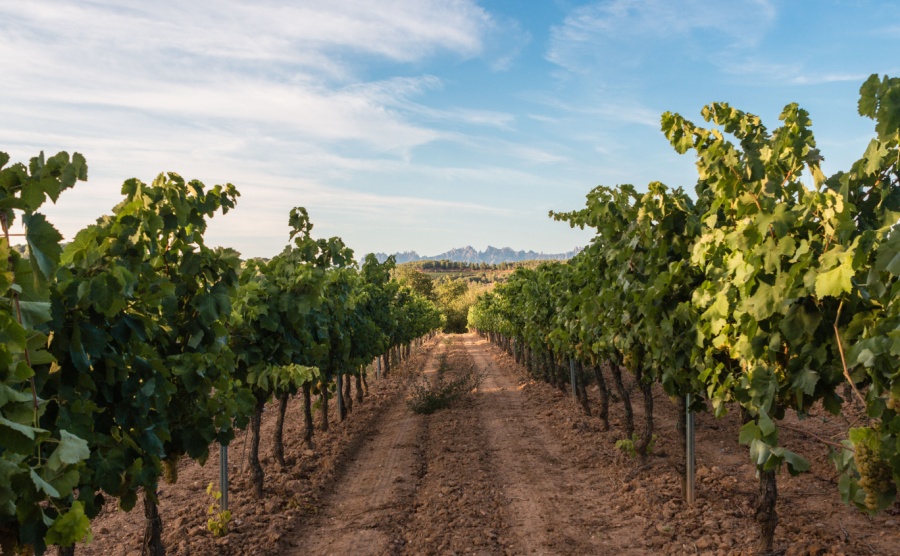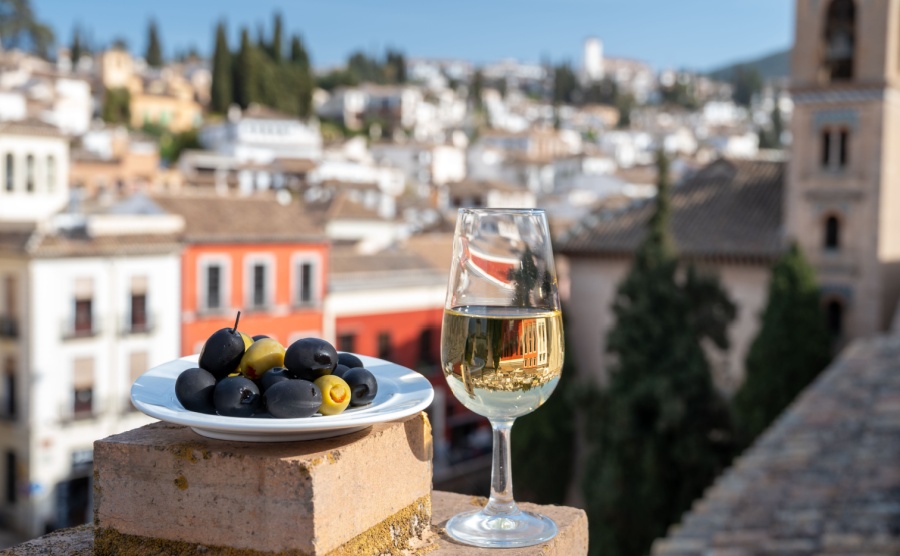Spain is of course the land of sun, sea and….wine! As it happens, grapes tend to thrive in the most beautiful regions. So, we thought we’d take some advice from Spain’s most beloved grapes on areas to buy in.
In a few weeks, the wine harvest and evaluations of wines from around the country will begin. 2024 has seen the worst drought conditions for many regions, Catalonia declared a serious drought for the first time in February. La Rioja and Andalusia have also experienced a much drier than normal climate. This will undoubtedly affect some wines in the 2024 vintage but many wine producers have taken measures for years to combat the changing weather patterns.
Torres, one of the best-known wine producers, began purchasing land in the cooler, higher altitudes as long ago as 2012, foreseeing the arrival of hotter and drier summers. Even in Galicia, the wettest part of Spain is affected by global warming. The Albariño grape is proving able to withstand the worst effects and is being planted in ever larger quantities.
However, all 17 Autonomous regions of Spain produce a wonderful variety of wines and the country produces more wine and has more land designated for wine than any other.
In this article, we look at just a few of Spain’s wines and regions. Many are places that appeal to non-Spaniards as well as locals for a gentle and laidback lifestyle. Imagine waking up to blue skies and sunshine and looking out onto rows of vines ripening in the warmth. Views across undulating hills, river valleys and plains, where well-tended vines move gently in the breeze.
Find homes in Spain via our property portal.
Penedès, Catalonia
This region produces some of Spain’s best wines. Just 42 km from Barcelona and also from Tarragona, Penedès is divided into three areas which include forests, sandy beaches and valleys dedicated to wine. These are Baix Penedés which includes the coast, Alt Penedés where most of the wine is grown and Garraf also by the coast backed by mountains.
You can enjoy this lovely region by bike, on foot and by car. The tradition of local produce and wines creates great culinary experiences and eating and drinking outside in one of the many excellent restaurants has to be one of life’s great joys.
Penedès is the home of Cava. The Phonecians produced wine here and today many varieties of grapes are harvested: Parellada, Macabeu, Xarello, Chardonnay, Pinot Noir and Subirat.
Calafell is a delightful village by the sea, known for its 5 km of beaches and castle. It also has an open-air Phoenician museum. Water sports and sailing are available, there are local restaurants but also many offering international cuisine and for golfers, there is the Club de Golf La Graiera. Local wines are found on all menus. The climate is Mediterranean with cool winters and warm summers.
Inland are many other pretty villages and small towns with a more rural flavour. The capital both of the region and the wine production, Vilafranca del Penedès, is a very pleasant city. As you would imagine, it hosts an important Wine Museum, and its Saturday market is home to 200 stalls selling everything from local produce to wine. It is a historical place with fine buildings and squares and offers a comfortable lifestyle for those who are content to be surrounded by vineyards and wonderful vistas. It is also home to the Castellers, the human towers of Catalonia.
Galicia
On the other side of Spain is the green and pleasant land of Galicia. It is a stunning region with a long history of sea, mountains, valleys and steep hillsides clothed in vines. This land was inhabited long before the Romans arrived and has its own very individual traditions and language.
The wine produced here is the Albariño, a white wine grown in the Rías Baixas, which means Lower Esturaries in Galician. This area enjoys cooler temperatures owing to the sea mists and fogs and is therefore less affected by temperature changes which can affect the grapes. The winter has heavy rainfall though less so recently because of global warming. Nevertheless, there are 2,200 hours of sun annually, so the grapes can ripen. Other grapes used are Treixadura, Loureira blanca, and Caiño blanca.
Galicia is best known for the city of Santiago de Compostela, its capital and where the pilgrim route Camino de Santiago ends. One of the prettiest towns in Galicia is Cambados which lies in the largest of Lower Estuaries, in the Valley of Salnés and is carved into granite. Typically, it has narrow cobbled streets, shady squares, hiking routes to the vineyards and offers water sports and marine activities.
Almost 5000 families earn their living through wine and its production and the town thrives due to Albariño. The local cuisine is considered amongst the best in Galicia and local seafood combined with Albariño makes a perfect meal. The town and surrounding area are perfect for people seeking culture and nature with the advantage of many activities and festivals.
Andalucía
Andalucía has a vast variety of wines produced in its regions. Its geographical makeup and climate are perfect for making wine. Lately, the lack of rain has affected wine and olive production but there are still many wines to enjoy. The main focus is on high-quality wines and many of the wineries and bodegas have also made efforts to combine architectural excellence with functional winemaking.
Huelva
Huelva is on the Costa de La Luz. Wines are made using the white Zalema grape, native to the region. The Condado de Huelva wine region lies in 5,000 hectares and produces 28,000,000 litres annually in 40 bodegas. Huelva wine is particularly good with seafood and has recently gained popularity. Other Andalusian wines are better known and marketed but a few producers are now making a sparkling white wine, Raigal, the only sparkling wine in the region.
Huelva is considered the “Jewel” of the province. It was from here that Christopher Columbus sailed to the Americas in 1492. The Phoenicians designated Huelva as a port and it grew in importance over the centuries. It also became a centre of mining minerals. It houses an early 20th century bullring and one of the grandest buildings, Casa Colón is a symbol of British presence in the town at that time.
About 90 minutes’ drive from Huelva is the appealing town of Ayamonte. Close to Portugal and on the banks of the river Guadiana, it began life as a tranquil fishing town. The nearest beaches are 5 km away but the region is comparatively unspoilt by tourism. The old town is typical of Andalusia with a warren of streets punctuated by little squares lined with restaurants and bars. Nearby is a wetland, Marismas del Guadiana which is of ecological importance. Golf is well catered for, as are water sports, hiking and sailing. Winters are very mild and summers are hot. Ayamonte has a very authentically Spanish feel, nowhere more so than in the town’s indoor market selling local wine and produce.
You might also like:














